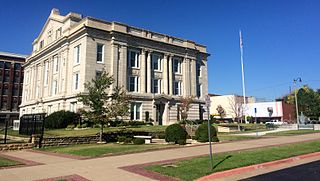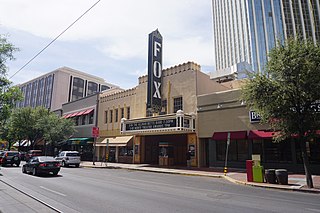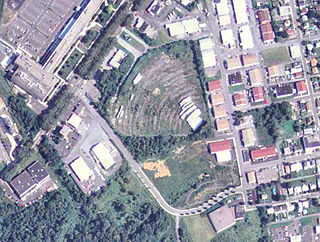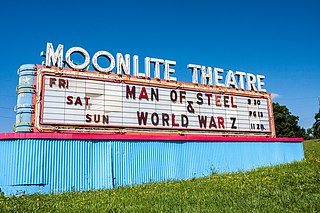
Bristow is a city in Creek County, Oklahoma, United States. The population was 4,222 at the 2010 census, down 2.4 percent from the figure of 4,325 recorded in 2000.

Sapulpa is a city in Creek and Tulsa counties in the U.S. state of Oklahoma and a suburb of Tulsa. The population was 21,929 at the time of the 2020 census, compared with 20,544 at the 2010 census. It is the county seat of Creek County.

A drive-in theater or drive-in cinema is a form of cinema structure consisting of a large outdoor movie screen, a projection booth, a concession stand, and a large parking area for automobiles. Within this enclosed area, customers can view movies from the privacy and comfort of their cars. Some drive-ins have small playgrounds for children and a few picnic tables or benches.

Fox Theatres was a large chain of movie theaters in the United States dating from the 1920s either built by Fox Film studio owner William Fox, or subsequently merged in 1929 by Fox with the West Coast Theatres chain, to form the Fox West Coast Theatres chain. Fox West Coast went into bankruptcy and was sold to The National Theatres Corporation, led by Charles Skouras, on November 20, 1933, for $17,000,000.00. Eugene V. Klein later became CEO of National, and turned it into the conglomerate National General. Mann Theatres bought National General's theatres in 1973.

The Turner Turnpike is a controlled-access toll road in central Oklahoma, connecting its two largest cities, Oklahoma City and Tulsa. Authorized by the Oklahoma Legislature in 1947 and opened in May 1953, it is the oldest of the state's eleven turnpikes. The route is signed as Interstate 44 for its entire length, but was constructed prior to its designation as such. The Turner Turnpike was named after Governor Roy J. Turner, who pushed for efforts to build this toll road to connect the state's two largest cities.

State Highway 66 is a 192.7-mile (310.1 km) state highway in the U.S. state of Oklahoma, beginning at U.S. Highway 81 in El Reno and ending at U.S. Highway 60 near White Oak. The highway was designated in 1985 as a replacement for the decommissioned U.S. Highway 66. Although most of the highway follows Historic Route 66, the highway follows US 66's final alignment, joining Interstate 44 through Tulsa and Oklahoma City, while older versions of the route follow various city streets through both cities.

U.S. Route 66 is a former east–west United States Numbered Highway, running from Santa Monica, California to Chicago, Illinois. In Missouri, the highway ran from downtown St. Louis at the Mississippi River to the Kansas state line west of Joplin. The highway was originally Route 14 from St. Louis to Joplin and Route 1F from Joplin to Kansas. It underwent two major realignments and several lesser realignments in the cities of St. Louis, Springfield, and Joplin. Current highways covering several miles of the former highway include Route 100, Route 366, Route 266, Route 96, and Route 66. Interstate 44 (I-44) approximates much of US 66 between St. Louis and Springfield.

The historic U.S. Route 66, sometimes known as the Will Rogers Highway after Oklahoma native Will Rogers, ran from west to northeast across the state of Oklahoma, along the path now taken by Interstate 40 (I-40) and State Highway 66 (SH-66). It passed through Oklahoma City, Tulsa, and many smaller communities. West of the Oklahoma City area, it has been largely replaced by I-40; the few independent portions that are still state-maintained are now I-40 Business. However, from Oklahoma City northeast to Kansas, the bypassing I-44 is mostly a toll road, and SH-66 remains as a free alternate.

The Wigwam Motels, also known as the "Wigwam Villages," is a motel chain in the United States built during the 1930s and 1940s. The rooms are built in the form of tipis, mistakenly referred to as wigwams. It originally had seven different locations: two locations in Kentucky and one each in Alabama, Florida, Arizona, Louisiana, and California.

The Fox Tucson Theatre is located in downtown Tucson, Arizona, United States. The theater opened on April 11, 1930 as a performance space in downtown Tucson. It hosts a wide spectrum of events and concerts featuring a variety of performing talent, ranging from ballets, to jazz, contemporary pop, world music and rock acts.

Pacific Theatres was an American chain of movie theaters in the Los Angeles metropolitan area of California. Pacific Theatres was owned by The Decurion Corporation which also owned and operated ArcLight Cinemas. In 2008, it sold its store locations in San Diego to Reading Cinemas. In April 2021, Pacific Theatres announced they would not be reopening any of their theater locations after being closed since March 2020 due to the COVID-19 pandemic. In June 2021, the company filed for Chapter 7 bankruptcy. Following the closure, some former Pacific locations were acquired by AMC Theatres.

The Homestead Historic Downtown District, is a U.S. Historic District located in Homestead, Florida, United States. It is bound by Northwest 4th Street, South Railroad Avenue, Southeast 1st Road and North Krome Drive.

66 Drive-In is a historic drive-in theater national historic district located on U.S. Route 66 in Carthage, Jasper County, Missouri. The theater opened on September 22, 1949, four years before the first local television stations signed on in the Joplin-Springfield area. In an era before widespread adoption of transistors and before the invention of integrated circuits, car radios were not standard equipment in all vehicles. The few radios installed in vehicles were of vacuum tube design and power-hungry by modern standards. A series of poles in the car park of the nine-acre site were therefore deployed to hold loudspeakers so that viewers could hear the movie.

Warren Theatres was a movie theater chain based in Wichita, Kansas, United States. While the company was founded by Bill Warren, he sold ownership of most of the Warren Theatres locations to Regal Entertainment Group in 2017. The sale excluded two theaters that were in development and the Palace Theatre in Springfield, Missouri.
The Midway Drive-In Theater was built in 1955 between Turkey and Quitaque, Texas, on Highway 86 when over 300 drive-ins were operating in Texas.

The Rock Café in Stroud, Oklahoma, a historic restaurant on U.S. Route 66, takes its name from the local sandstone used in its construction.

The Boulevard Drive-In Theater is a closed drive-in theater, located in Allentown, Pennsylvania. It was one of two drive-in theaters in Allentown; the second one was Cinema Treasures.

The Moonlite Theatre, also known as the Moonlite Drive-In, is a historic drive-in theater located near Abingdon, Washington County, Virginia. It was built and opened in 1949, and remained one of the few drive-ins still open in Virginia until finally closing in 2013. The theater reopened briefly in 2016 but closed shortly after due to a pending lawsuit. Remaining original buildings and structures include the 65-foot-tall screen tower and office wing, the ticket booth, the concession stand/projector booth building, and the neon-illuminated attraction board at the edge of the highway. The theatre includes 454 parking/viewing spaces designed as reverse-incline ramps.
Tee Pee Restaurant was a drive-in restaurant in Indianapolis, Indiana, that began business in 1932. In 1939, the original building on Fall Creek Boulevard was replaced with one having a central stuccoed teepee-shaped section with identical flanking wings. A cantilevered canopy extended around the building. Additions were made to the wings in 1952.















